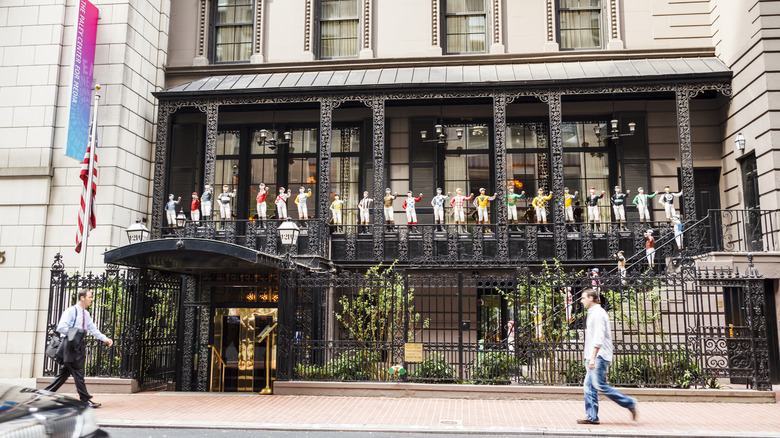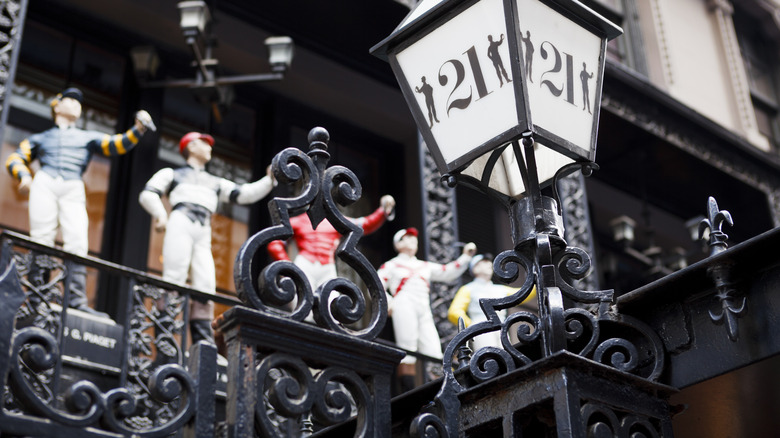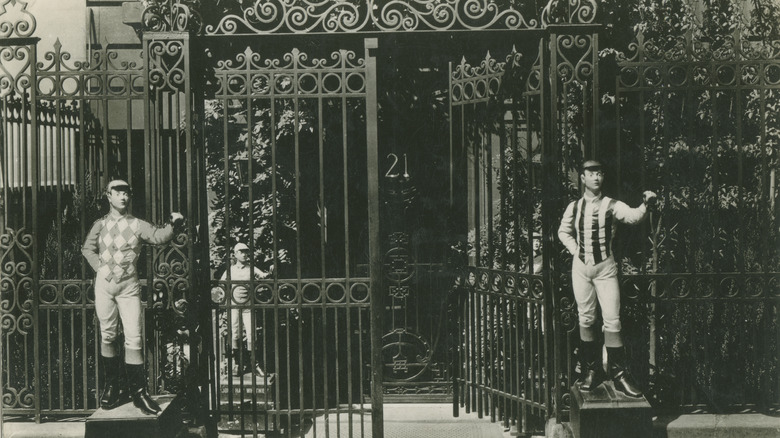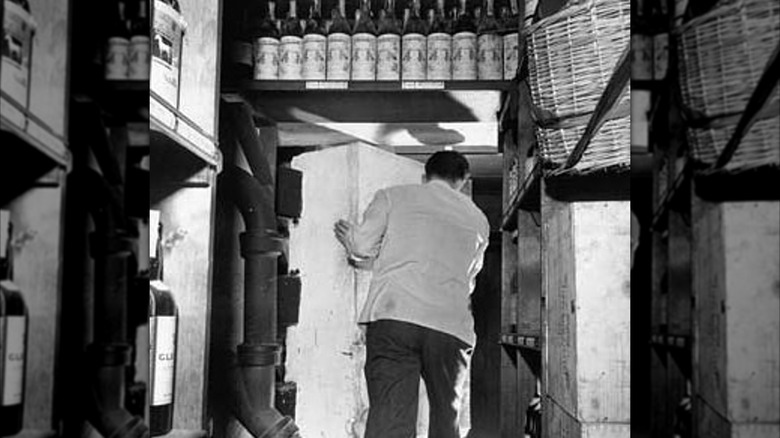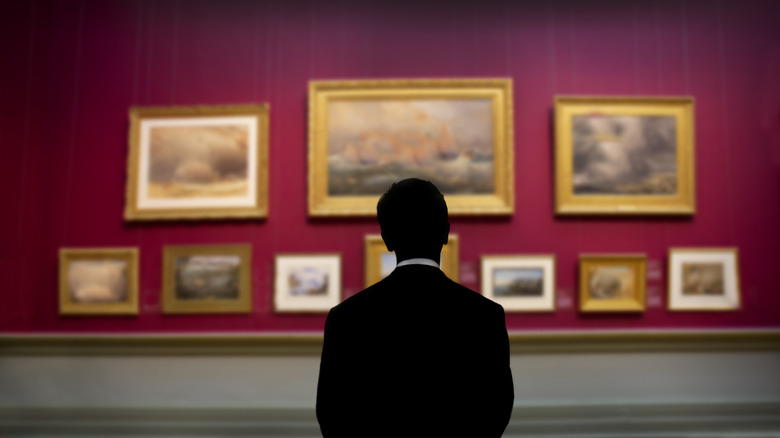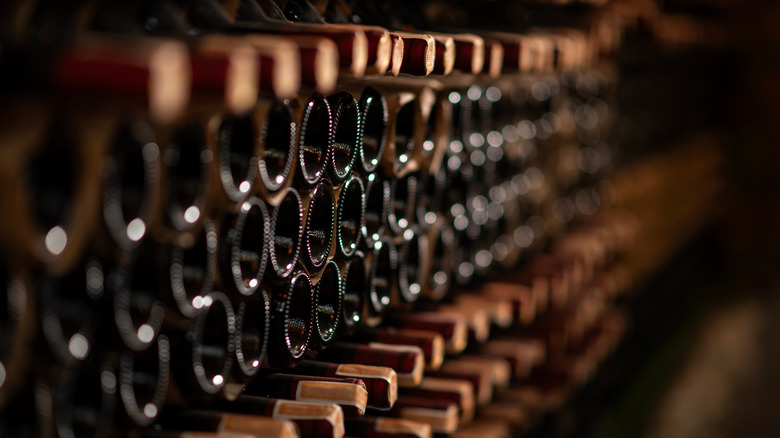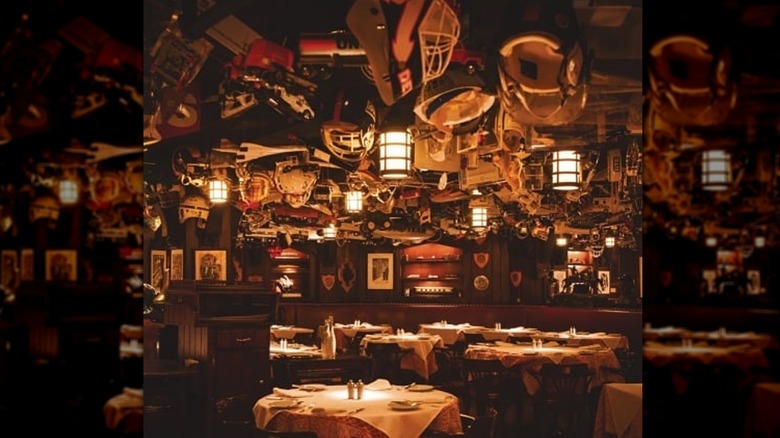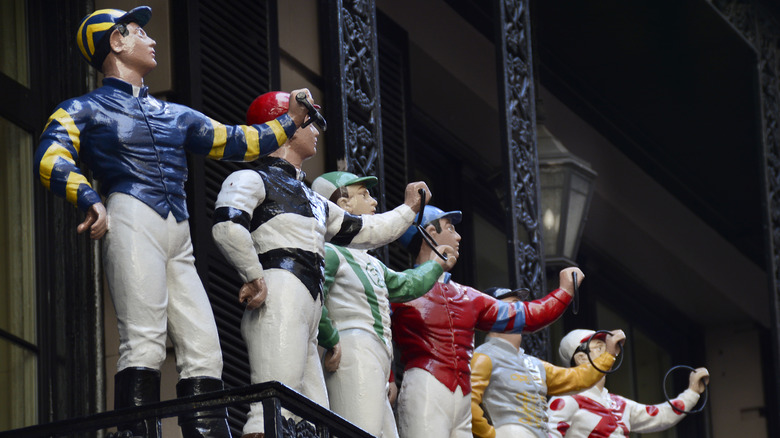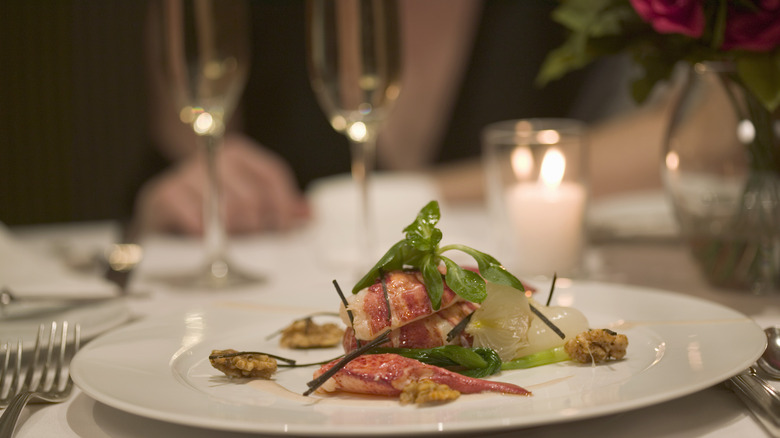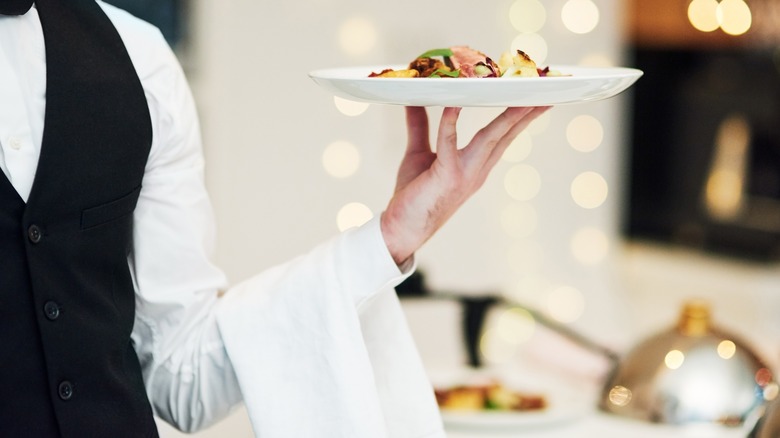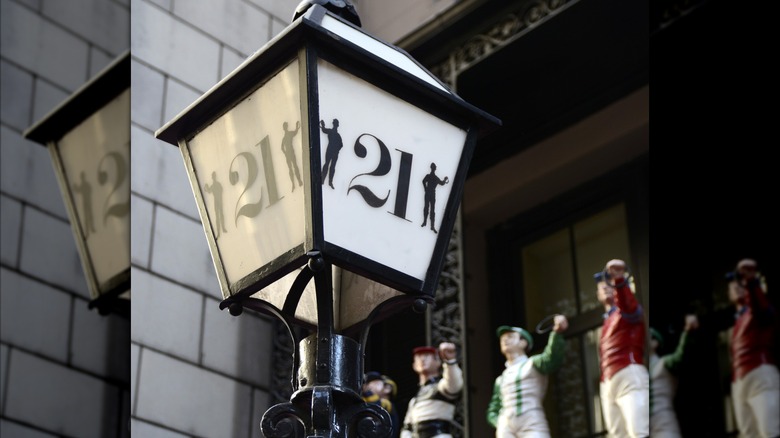'21' Club: 11 Facts About Donald Trump's Favorite NYC Restaurant
It was more than your run-of-the-mill New York City steakhouse. With its outlines of iron and gold, '21' Club was an icon, a landmark, a space embodying the timeless charm for which the Manhattan borough is known. This classic upscale American restaurant and former speakeasy seemed to ooze rich history, with stardust from the celebrities that regularly wined and dined within its walls still lingering in the air. While U.S. president and controversial foodie Donald Trump, who held a wedding reception at '21' in 1977, was one of the restaurant's regular attendees, every serving American president since the club's opening reportedly indulged in its famous fare.
But it wasn't just politicians who found satisfaction in a plate and drink from the once-thriving clubhouse. Old Hollywood star Elizabeth Taylor, actor Harrison Ford, renowned singer Mae West, business tycoon Aristotle Onassis, and countless others were likewise frequenters to New York's chicest social spot. Even classic cinema icon Humphrey Bogart proposed to his bride, actress Lauren Bacall, at a '21' table that became endearingly known as "Bogie's Corner." But when you peel back the curtain of romanticism shrouding the fairy-tale restaurant that seemed to transport modern-day patrons to another time, what really made this legendary spot what it was? From secret cellars to jockey statues to the strictest of dress codes, here are 11 facts about Donald Trump's beloved '21' Club.
The wrought-iron gate outside the restaurant's front door was an integral part of its story
A wrought-iron gate surrounding a property has become an effortless symbol of prestige, with a set of sturdy, patterned bars demanding an innate sense of awe from onlookers. This is the feeling that inevitably stirred within the rumbling bellies of patrons to the '21' Club restaurant as they approached, the sight of the overawing black iron structure being one of the first of the space's physical attributes to meet their eyes. Complete with swirling designs and spikes in the traditional architectural style, the gate surrounding the perimeter of the clubhouse quickly became one of its most notable qualities — an embodiment of the distinction '21' freely projected.
However, there is more to this decorative fence than meets the eye. '21' Club's wrought-iron boundary, forged in 1926, was actually installed at a different address first — the initial space in which the restaurant was supposed to sit. Just after Jack Kriendler and Charlie Berns, the club's dual founders, opened the doors of the initially-named "Puncheon Grotto" eatery on 42 West 49th Street, they were informed that the construction of Rockefeller Center would be going into effect right on top of their newly-established business. Undeterred, the two selected a different venue three blocks over — 21 West 52nd Street. They picked up their wrought-iron staple, took it with them, and renamed their relocated restaurant '21' Club. The rest, as they say, is history.
'21' Club opened in 1930, in the midst of Prohibition
By the early 1900s, a number of women's rights and religious groups had grown to believe that the root of all evil in the United States was alcohol. This belief gained momentum, becoming a powerful social movement ... and, eventually, an amendment. Many Americans were thrown into a state of shock in 1920 when the sale, production, and transportation of spirits, beer, and wine of any kind (with the exception of whiskey) was outlawed via the 18th Amendment, beginning an era known officially as Prohibition. How did the American public react? By finding ways to raise a toast anyway, of course. One of the most common methods for safely and discreetly purchasing a refreshing, ice-cold dark porter was through speakeasies; secret bars that illegally sold alcohol to thirsty patrons during this infamous period in American history.
Though '21' Club may have publicly advertised itself as an innocent upscale restaurant after its official opening in New York City on West 52nd in 1930, it became known throughout the rustling, thirsting community as a charming speakeasy — a spot in which one could reliably snag a glass of red or a classic Old Fashioned cocktail alongside a plate of luxurious American fare, such as soups and scallops. Thankfully for '21,' it would only have to operate in illegality for three more years, as Prohibition met its official end in 1933.
'21' Club had secret rooms for hiding liquor
Even though the rumor that the U.S. government may have been intentionally poisoning alcohol during Prohibition is unlikely to be true, there were certainly severe limitations for businesses caused by the law. '21' Club — which remained ever-stocked with liquor despite the national no-alcohol policy — had to be intentional and creative about safeguarding itself from the constant threat of raids by law enforcement. After being caught red-handed with the goods during a search in their very first year of operation, owners Jack and Charlie were determined to avoid a repeat scenario. To preserve their vast amounts of liquid gold, the pair went the extra mile ... a mile so unbelievable, it seemed fit for a Hollywood action flick.
The founders of '21' brought in an architect by the name of Frank Buchanan to assist in the construction of an array of uniquely blended doors, discreet chutes, pirouetting surfaces, and an expansive hidden wine cellar — all intended for the sole purpose of concealing an alcoholic stash fit for the gods. Interestingly enough, the club's cellar, its most famous hiding space, was designed in such a way that it technically fell within the boundaries of the neighboring building — thus, restaurant staff could report to authorities with a clean conscience that there was no alcohol on site. These extraordinary efforts paid off, as the speakeasy is said to have remained free of any further legal issues until Prohibition met its end.
Large bar tabs were sometimes paid with rare pieces of art
'21' Club owners Jack Kriendler and Charlie Berns were more than just restaurateurs with a dream — they were avid art enthusiasts and eager collectors. And where was their colorful trope of talent housed? Why, on the walls of their club, of course. The duo proudly adorned their restaurant in a colorful collage of eye-catching art, from original works by American painter Frederick Remington all the way to the fun-loving illustrations by Walt Disney himself. Pieces by visual artist McClelland Barclay, doodles by celebrated cartoonist Peter Arno, and an array of others contributed to the rich tapestry of the esteemed eatery's collection.
One aspect which made this one-of-a-kind exhibition even more intriguing is the way in which some of its pieces were acquired. Allegedly, some of the paintings and drawings that charmed dining customers for so many years had served as payments during the Great Depression by patrons who were unable to pay their bar tabs. Though which of the club's eccentric assemblage was used as currency, and by whom, remains a mystery, these unknowns only seemed to amplify the air of enigma surrounding Jack and Charlie's unforgettable cluster.
'21' Club housed wine for the likes of Richard Nixon and Sophia Loren
The popularized secret cellar installed deep within famed bar and restaurant '21' Club during the age of Prohibition was not only used to hide the establishment's coveted collection of red and white wines from snooping authorities — it also served as the secure rental space for select patrons' personal wine collections. But '21' wasn't in the business of housing just any old customers' picks: only the wines of some of the club's most esteemed members were stacked among the clubhouse's staggering 2,000-bottle collection in the alluring vault. Glamorous Hollywood actresses Sophia Loren and Elizabeth Taylor, American presidents Richard Nixon and Gerald Ford, as well as one of the world's most wealthy men, businessman Aristotle Onassis, reportedly all relied on '21' Club to keep their most prized bottles aging safely.
Nevertheless, the details surrounding these arrangements remain unclear. Whether or not the clubhouse's star-studded renters were required to pay for the space their collections required in the cellar, or if the simple promise of frequent visits to the restaurant was enough to pay this particular tab, is a mystery. One way or another, though, storing wine for some of the world's most famous individuals is undoubtedly going to be good for business.
The ceiling of its bar room was adorned with toys and oddities
'21' Club may have had a decorative front fence, a line of jockey guardians, and walls adorned by a vast art collection, but its unique — bordering on outlandish — decor didn't stop there. Arguably, the restaurant's greatest visual gallery was to be found on the ceiling of its main Bar Room — which was covered every inch-full in classic toys.
Though this may initially sound anticlimactic, it wasn't just your standard model cars, planes, or boats that hung suspended in full view of the restaurant's dining patrons. This one-of-a-kind collection of hanging knick-knacks was gifted, one-by-one, to the club by notable clients — like the PT-109 torpedo boat donated by President John F. Kennedy, or the miniature Air Force One given by President Clinton. Among these were also priceless sports mementos, such as center fielder WIllie Mays' baseball bat, racquets from tennis players Chris Evert and John McEnroe, as well as a golf club from "the Golden Bear" himself, retired player Jack Nicklaus. '21' consistently upheld that its ceiling was one of the most unique on Earth — and looking upon this jumble of dangling priceless artifacts, it's impossible not to concede.
The iconic jockeys near the '21' Club entrance represented the best in racing
It was in the early days of '21' Club's operation when Jay Van Urk, a regular diner and passionate sports enthusiast, gifted his favorite restaurant with its very first jockey statue. Owners Jack and Charlie placed their newest addition on guard atop the balcony outside, and soon, a row of similar horse-riding sculptures lined the space above the front entrance of the clubhouse. Though the frozen racers hold their arms outward in an act of gripping the steel loops indicative of their sport, the gesture feels vaguely reminiscent of a "toast" — a natural addition for a world-class bar.
The jockey statues not only grew in number over the years, they also grew in prestige. The families of some of the biggest names in racing, like thoroughbred tycoon Alfred G. Vanderbilt, famed rider Paul R. Mellon, and breeder Ogden Mills Phipps, followed suit, contributing statue donations for the colorful lineup that became an integral part of the club's identity and image. Sadly, upon the restaurant's closing, the ever-watching jockeys were removed from their mount — casting an immediate, eerie emptiness over Manhattan's West 52nd Street.
Its fare came with notably high prices
Given its star-studded clientele, it shouldn't feel too surprising that the menu at '21' Club came attached with some seriously elevated price tags. This was reportedly the case from the get-go, with the restaurant being considered notoriously expensive even from its inception in the early 1900's. Lifestyle magazine Cigar Aficionado explored this back in a 1992 issue featuring a spokesperson from '21', who expressed no qualms regarding the club's lavish reputation.
The article featured the former chairman of '21', Ken Aretsky, who discussed the world-class status of the restaurant's dishes and wine offerings. He stated that the establishment "still has the sensibility of the era of Fred Astaire and Ginger Rodgers," while adding unashamedly: "It is a very expensive restaurant, but we give great value." The issue outlined specifically the prices on some of the restaurant's most popular picks at the time, such as the burger, which went for $21.50, the chicken hash for $23, or the eggs with caviar at $40. These could be considered notable even by today's standards — but back in 1992, they could easily have been regarded as astronomical for some. The wine bottles in the cellar, the rarest of which went for well over $2,000 a piece in the '90's, were yet another sizable consideration for the overall bill.
Dining patrons were expected to wear jackets -- even in the modern era
Once upon a time, social norms dictated that formal attire was to be worn at dinner. Early 20th century upper class citizens, in particular, made a show of getting dressed in their best for dinner parties, or a night out at an upscale restaurant. But though the days of ties, gloves, fancy hats, tailored suits, cocktail dresses and fancy shoe requirements for eateries may be long gone, '21' Club remained dedicated to keeping these hallmarks of classic elegance alive until the very end. Still equipped with uniformed doormen, greeters, coat-checkers, and bathroom attendants, it wasn't until 2009 that the restaurant loosened up the strictness of its formal dress code slightly by relinquishing its long-upheld neck tie requirement for men.
This change, one might say, was inevitable, brought on by the beast of modernization as well as economic downturn — which had begun to make dining patrons scarcer. '21', realizing it could no longer afford to turn down hungry customers on the basis of a lack of necktie, began allowing for this slight breach in antiquated etiquette ... but that is not to say it's standards were abandoned entirely. At the time of its closure, '21' was still requiring its male patrons to wear jackets — a dress code demand virtually unheard of in this day and age.
It fell victim to the COVID-19 pandemic in 2020
One could argue that no single field on Earth was impacted worse than the restaurant industry during COVID-19. The National Restaurant Association estimates that a near-unbelievable 100,000 restaurants closed six months after the onset of the pandemic — and at least 1,000 of these were reportedly from New York City. Though the rich history and sense of timelessness surrounding Manhattan's '21' Club made the magical establishment feel untouchable, unfortunately, not even this classic hangout for movie stars, billionaires, and political powers turned out to be exempt from the troubles that came along with the worldwide shutdown.
In March 2020, like so many others, '21' Club shuttered its doors in response to COVID-19 — the severe lack of business generated by social distancing requirements, as well as consumer nervousness about dining out safely in the first place, being impossible to weigh against the cost of operation. Patrons waited with baited breath for the news of the nearly hundred-year-old establishment's reopening ... but what came instead was an announcement of gut-wrenching sentiment. Nine months later, in December of 2020, the word was officially released that one of the nation's most famous speakeasies would be closing for good — the end of an era.
Despite the assurance of a reopening, the lights remained dimmed at '21' Club
When the news of the closing of '21' was released, there was a hefty share of skepticism regarding the shutdown's supposed permanence. After all, hadn't the restaurant's owners promised to wine and dine its patrons once again, as owners Jack and Charlie had always wanted, when the pandemic-induced smoke had cleared? "For 90 years, '21' Club has been a social and cultural icon of this wonderful city we call home," the club posted to its official Facebook page on December 18, 2020, "and it is our firm intention to continue [...] New York's illustrious past and a celebrated venue of timeless elegance is central in formulating our future plans; which we will announce as soon as they are developed, refined and finalized."
Despite this seeming bit of assurance, there has been nothing but crickets as regards future plans for the historic premises since. The windows of the former '21' remain shuttered, and the jockeys are missing from their rightful throne; the absence serving as a ghostly testament to all that was. It seems an injudicious end for such a vibrant and iconic New York City staple ... and, perhaps, this is why consumers continue to wait and hope. One day, they pray, the doors will open on this legendary establishment once again, and this piece of living history will persist with every drink poured at its bar.
